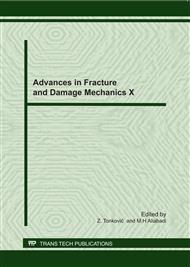p.533
p.537
p.541
p.545
p.549
p.553
p.557
p.561
p.565
An Experimental and Numerical Investigation of the Mixed-Mode Fracture Toughness and Lap Shear Strength of Aerospace Grade Composite Joints
Abstract:
In the present study, the mixed-mode fracture toughness of an adhesively bonded composite joint system was examined using a variety of linear elastic fracture mechanics (LEFM) based tests. These tests include the mode I double cantilever beam (DCB), mixed-mode asymmetrical DCB (ADCB) and mode II end load split (ELS) test. The joint system was also evaluated using the wide area lap shear (WALS) test that is often employed by the aerospace industry. While lap shear type tests are relatively simple to perform and post-process compared to their LEFM counterparts, the results can often be misleading and are greatly dependent on the overlap length, thickness of substrate and type of fillet. The experimental tests were also simulated using OpenFOAM, a finite volume based software package. Through this combined experimental-numerical approach, a greater understanding of the influence of the peel ply surface treatment and scrim cloth on the behaviour of the WALS test was achieved.
Info:
Periodical:
Pages:
549-552
Citation:
Online since:
September 2011
Authors:
Keywords:
Price:
Сopyright:
© 2012 Trans Tech Publications Ltd. All Rights Reserved
Share:
Citation:


